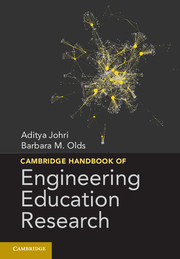Book contents
- Frontmatter
- Dedication
- Contents
- Editors
- Contributors
- Foreword
- Acknowledgments
- Introduction
- Chapter 1 Chronological and Ontological Development of Engineering Education as a Field of Scientific Inquiry
- Part 1 Engineering Thinking and Knowing
- Part 2 Engineering Learning Mechanisms and Approaches
- Part 3 Pathways into Diversity and Inclusiveness
- Part 4 Engineering Education and Institutional Practices
- Chapter 19 Translating Research to Widespread Practice in Engineering Education
- Chapter 20 Research-Guided Teaching Practices
- Chapter 21 Engineering Instructional Development
- Chapter 22 Understanding Disciplinary Cultures
- Chapter 23 Preparing Engineering Educators for Engineering Education Research
- Part 5 Research Methods and Assessment
- Part 6 Cross-Cutting Issues and Perspectives
- Index
- References
Chapter 19 - Translating Research to Widespread Practice in Engineering Education
Published online by Cambridge University Press: 05 February 2015
- Frontmatter
- Dedication
- Contents
- Editors
- Contributors
- Foreword
- Acknowledgments
- Introduction
- Chapter 1 Chronological and Ontological Development of Engineering Education as a Field of Scientific Inquiry
- Part 1 Engineering Thinking and Knowing
- Part 2 Engineering Learning Mechanisms and Approaches
- Part 3 Pathways into Diversity and Inclusiveness
- Part 4 Engineering Education and Institutional Practices
- Chapter 19 Translating Research to Widespread Practice in Engineering Education
- Chapter 20 Research-Guided Teaching Practices
- Chapter 21 Engineering Instructional Development
- Chapter 22 Understanding Disciplinary Cultures
- Chapter 23 Preparing Engineering Educators for Engineering Education Research
- Part 5 Research Methods and Assessment
- Part 6 Cross-Cutting Issues and Perspectives
- Index
- References
Summary
Introduction
Governmental, academic, and professional organizations around the world have pointed to the need for changes in engineering education to meet global and national challenges (see, e.g., Australian Council of Engineering Deans, 2008; National Academy of Engineering, 2004; Royal Academy of Engineering, 2007). Some of these organizations have specifically pointed to the need for the changes in engineering education to be based on educational research (Jamieson & Lohmann, 2009, 2012; National Research Council [NRC], 2011). In spite of these calls for change, researchers are finding that the rate of change and the nature of the change are not keeping pace with the calls for change.
Reidsema, Hadgraft, Cameron, and King (2011) ask “why has change (in engineering education in Australia) not proceeded more rapidly nor manifested itself more deeply within the curriculum” (p. 345) in spite of funding from the national government and continuing efforts of engineering professional societies and Australian Council of Engineering Deans? Reidsema et al. report that interviews of sixteen coordinators of engineering science units at four different universities in Australia revealed that traditional lecture combined with tutorials remained the dominant model of instruction. An in-depth study of the state of engineering education in the United States by Sheppard, Macatangay, Colby, and Sullivan (2009) makes the case that “in the midst of worldwide transformation, undergraduate engineering programs in the United States continue to approach problem-solving and knowledge acquisition in an outdated manner” (Schmidt, 2009, p. 1).
- Type
- Chapter
- Information
- Cambridge Handbook of Engineering Education Research , pp. 375 - 392Publisher: Cambridge University PressPrint publication year: 2014
References
- 7
- Cited by

